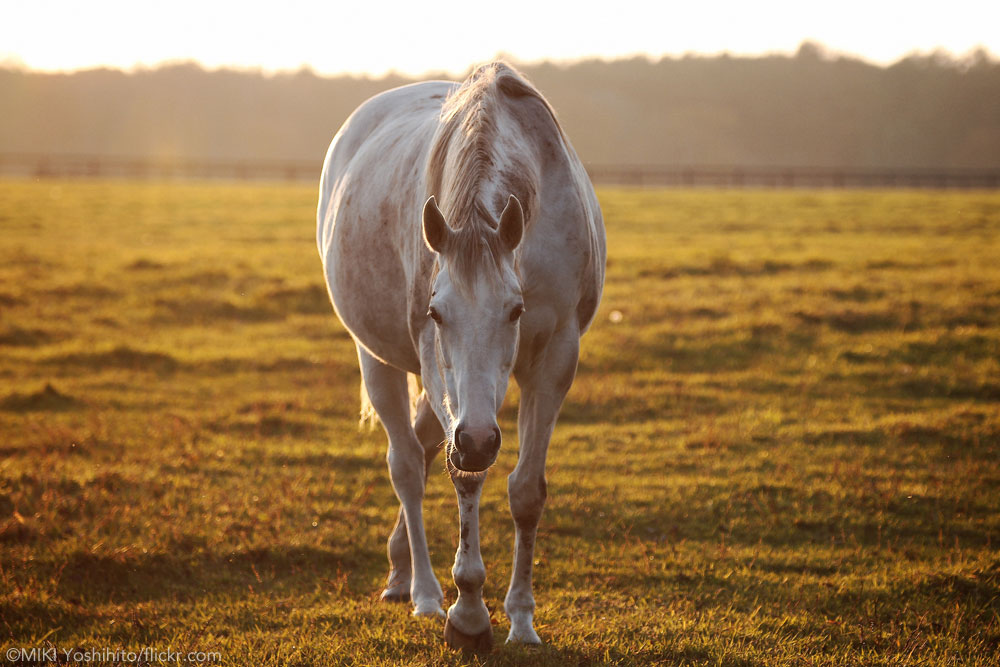In the early 1900s, Jill Girardi-Thomas’s father, Monte, started a business using his team of horses and a wagon to haul potatoes at Chicago’s South Water Market. Years later, he bought his daughter her first horse. Today, Girardi-Thomas breeds and trains Arabian horses, and she credits her career choice to the day her father gave her that gift horse.

Home for a Lifetime
Ideally, every horse would find a home with a caring owner and remain there throughout his life. But in reality, that’s rarely the case. In fact, most horses residing in the U.S. today will be in seven homes during their lifetimes. On average, they remain in each home for about three years, says Ashley Furst, director of the Unwanted Horse Coalition, an organization focused on finding out why some horses become homeless and how the equine industry might help them.
According to Furst, the Unwanted Horse Coalition grew out of a 2005 meeting of veterinarians and horse industry organization members to brainstorm the reasons—financial or otherwise—that horses were likely to become homeless, neglected or worse.
“At the time, we called them ‘unwanted horses’ for want of a better term,” says Furst.
Three years later, the start of the Great Recession made the cost of horsekeeping impossible for some owners to bear, and the ranks of those so-called unwanted horses swelled. Some of those horses entered what has become known as the “slaughter pipeline,” where they were sold at auction to buyers who then resold them to horsemeat processing plants in Canada and Mexico.
Other horses were left to starve in overgrazed pastures and confiscated by local law enforcement as part of animal cruelty investigations. Still others were voluntarily surrendered by their financially strapped owners. The majority of those animals were placed with equine humane organizations that fed them, provided veterinary care, and attempted to find them adoptive homes.
What to do Now
But even now that the economy seems to have stabilized, an estimated 100,000 horses are still deemed unwanted every year, according to Unwanted Horse Coalition figures.
“A 2012 survey by the University of California at Davis [UC Davis] also estimated that there were 100,000 so-called unwanted horses,” says Furst. “The same survey estimated that there were 14,000 [equine] rescue organizations in the U.S. [to assist them].”
Staggering as the number seems, Tom Lenz, DVM, Dipl. ACT, a longtime advocate for equine welfare and past chairman of the Unwanted Horse Coalition, believes that it may be even higher.
“It’s tough to say because there are also horses in pastures and shelters somewhere that we don’t know about,” says Lenz.
Whatever the figure, Christy Counts, president of the Right Horse Initiative, believes that it’s critical to find a new term to describe horses whose circumstances are changing in order to prevent them from becoming homeless or worse.
The Right Horse Initiative is operated by The WaterShed Animal Fund, which provides ongoing support to the initiative. The initiative was established to increase the number of horses adopted annually in the U.S. by promoting successful matches between horses and their owners.
The Right Horse Initiative also partners with equine rescue organizations to eradicate the stigma often associated with horses that are placed in rescue or equine humane organizations after becoming the subjects of law enforcement cases, or because they were voluntarily given up by their owners.
Horses in Transition
Rather than label these animals unwanted, or even rescued, the Initiative uses the term “horses in transition” to describe animals that are in need of a safe new home for any reason. Often horses come into transition through no fault of their own and are not “unwanted horses.”
“Horses come into transition because their owners have outgrown them, have had changes in their financial situation and can’t afford them, or because their owners have died or become physically unable to look after them,” Counts explains. “We’re trying to get away from the term ‘unwanted horse’ or even rescue horse because many of these horses are not need of rescue, they are just invisible.”
Jerry Finch is the founder of Habitat for Horses, an equine humane organization that takes in horses confiscated by law enforcement authorities as part of animal cruelty cases, agrees. In times past, nearly everyone had a horse: for transportation, for farming, or to operate a business, Finch says. As machines began to dominate those activities, the financial value of horses diminished.
“Instead of seeing the end of humans’ relationship with horses, what we’re seeing is the end of monetization of the horse,” says Finch. “Value is what people perceive it to be, and today it’s in a hobby: polo, hunter/jumper competitions or eventing.”
Matching Skill Sets
Attaching value to the animal is key.
As a result, Counts believes that the best way to maintain or even enhance the value of horses in transition is matching the animal’s skills with his owner’s skills throughout both their lives. That means that the horse may move on to new homes and new owners whenever his current owner’s personal circumstances change.
“For example, when she’s learning, a young rider gets a horse suited to her skills,” says Counts. “When she outgrows that horse, she sells it to another rider whose skills match the horse’s, and she acquires a more challenging horse. The cycle just keeps going.”
When that cycle involves placing a horse with an equine humane organization, training is critical to adoption. So is making a good match between the horse and his prospective new owner. The process is time-consuming and costly, Finch says, but it’s vital.
“When a horse comes to us, we have no idea what he can do, so first we find out if he can perform basic tasks: haltering, loading, having his feet picked up” says Finch. “Then our trainers work with him to see what jobs the horse is most suited to.”
Once the animal is made available for adoption, prospective owners are carefully screened to make sure they are compatible with the horse they hope to adopt, he says.
“If someone comes in and says, ‘I want a young horse because I have a 5-year-old child,’ that’s just not going to work,” says Finch.
Financial Offset
All told, the organization may spend between $5,000 and $6,000 to ready a horse for an adoption that costs the new owners less than $1,000.
“Obviously, we have more invested in the horse than we get for the adoption,” says Finch.
Meanwhile, the Unwanted Horse Coalition is stepping up to ease that burden. In its effort to encourage adoptions, the Coalition is offering financial grants so that equine humane organizations can sponsor clinics that geld stallions free of charge. The idea is to make horses residing in those organizations more appealing to potential new owners, and to possibly convince current owners to keep the horses they already have. The strategy seems to be working, Furst says.
“We recently surveyed rescue organizations that participated in gelding clinics, and 94 percent said that gelding horses made them easier to train,” she explains. “Also, 94 percent said that gelding the horses made them easier to adopt out, and that some owners decided to keep their horses after they were gelded.”
But despite the industry’s best efforts, horses that come through equine humane organizations are not always a prospective owner’s first choice. That’s because some prospective owners have certain notions about the value of these animals.
“It amazes me that people will pay $2,500 for a horse but won’t spend $1,000 for a rescue horse,” says Finch. “That horse is exactly the same—in fact, it’s probably better.”
The Right Job
That’s why Lenz believes changing that notion is crucial to preventing horses from becoming at risk in the first place.
“There are horses that will never be trained, that are permanently lame or have behavior issues, but horses that can be trained should go on to other careers,” Lenz maintains. “It’s about making good matches, but ultimately it’s also about giving prospective owners options, such as recognizing that some people don’t want to ride, but they want a horse for a pet, so maybe the horse’s new career will be just living in a pasture.”
For now, the equine industry remains engaged in a debate to determine how the “unwanted horse” moniker might be swapped for a more positive one. But even while that debate goes on, the industry will continue to pursue a solution, says equine behaviorist Jennifer Williams, Ph.D., founder of the Bluebonnet Equine Humane Society and author of How to Start and Run a Rescue.
“It’s a matter of semantics on which the horse industry cannot agree right now, and though I wish every horse had someone to care for him all of his life, there will always be horses in need of a safe place for any number of reasons,” says Williams. “In the meantime, we will continue to look to horses because they are our best friends, our healers and our escape. In the past, everyone kept a horse for practical reasons. Now we do it for love.”
For Finch, there’s an even more basic reason why every horse should be wanted.
“There’s an intrinsic value in all things that are alive,” he says. “The value is in those things themselves—including horses.”
PATRICE D. BUCCIARELLI is an award-winning freelance writer based in Florida.
This article originally appeared in the January 2018 issue of Horse Illustrated magazine. Click here to subscribe!





